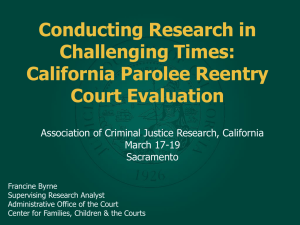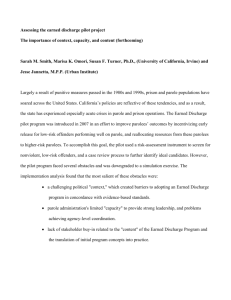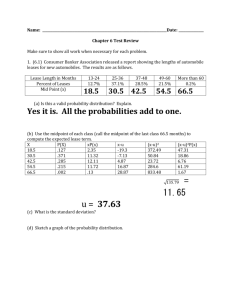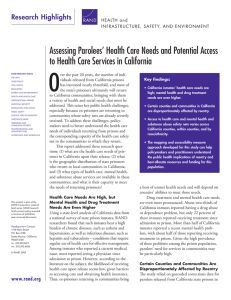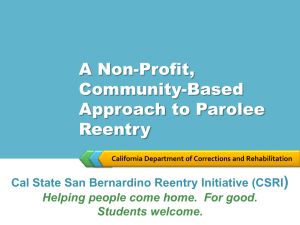HEALTH SAFETY, AND ENVIRONMENT 6
advertisement
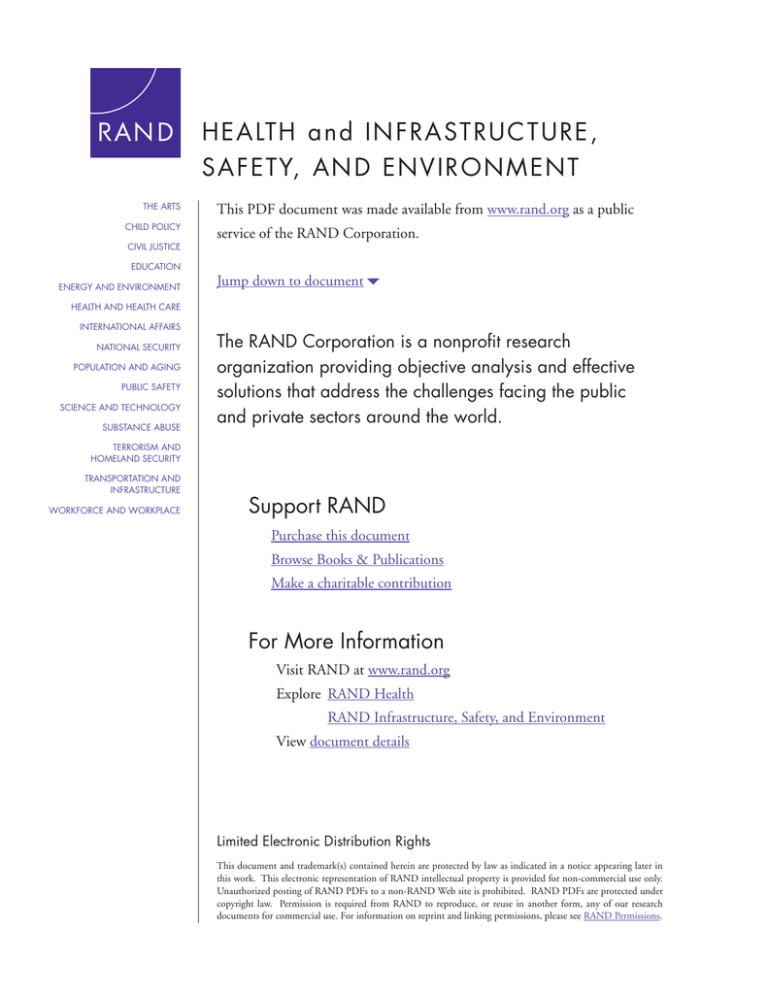
HE A LT H an d I NF RAS TRUCTURE, SA F ET Y, A ND ENVI RONMENT THE ARTS CHILD POLICY CIVIL JUSTICE EDUCATION ENERGY AND ENVIRONMENT This PDF document was made available from www.rand.org as a public service of the RAND Corporation. Jump down to document6 HEALTH AND HEALTH CARE INTERNATIONAL AFFAIRS NATIONAL SECURITY POPULATION AND AGING PUBLIC SAFETY SCIENCE AND TECHNOLOGY SUBSTANCE ABUSE The RAND Corporation is a nonprofit research organization providing objective analysis and effective solutions that address the challenges facing the public and private sectors around the world. TERRORISM AND HOMELAND SECURITY TRANSPORTATION AND INFRASTRUCTURE WORKFORCE AND WORKPLACE Support RAND Purchase this document Browse Books & Publications Make a charitable contribution For More Information Visit RAND at www.rand.org Explore RAND Health RAND Infrastructure, Safety, and Environment View document details Limited Electronic Distribution Rights This document and trademark(s) contained herein are protected by law as indicated in a notice appearing later in this work. This electronic representation of RAND intellectual property is provided for non-commercial use only. Unauthorized posting of RAND PDFs to a non-RAND Web site is prohibited. RAND PDFs are protected under copyright law. Permission is required from RAND to reproduce, or reuse in another form, any of our research documents for commercial use. For information on reprint and linking permissions, please see RAND Permissions. This product is part of the RAND Corporation technical report series. Reports may include research findings on a specific topic that is limited in scope; present discussions of the methodology employed in research; provide literature reviews, survey instruments, modeling exercises, guidelines for practitioners and research professionals, and supporting documentation; or deliver preliminary findings. All RAND reports undergo rigorous peer review to ensure that they meet high standards for research quality and objectivity. TECHNIC A L REP O RT Understanding the Public Health Implications of Prisoner Reentry in California Phase I Report Lois M. DavistNancy NicosiatAdrian OvertontLisa Miyashiro Kathryn Pitkin DerosetTerry FaintSusan Turner Paul SteinbergtEugene Williams III Prepared for The California Endowment H EALT H and INFR AST R UC TU RE, S A FE TY, A ND E NVI RONMENT This work was prepared for The California Endowment and produced within the RAND Health Promotion and Disease Prevention Program (HPDP) and the RAND Infrastructure, Safety, and Environment (ISE) Safety and Justice Program. Library of Congress Cataloging-in-Publication Data Understanding the public health implications of prisoner reentry in California : phase I report / Lois M. Davis ... [et al.]. p. cm. Includes bibliographical references. ISBN 0-8330-4753-1 (pbk. : alk. paper) 1. Parole—Health aspects—California. 2. Prisoners—Health and hygiene—California. I. Davis, Lois M. II. Rand Corporation. [DNLM: 1. Prisoners—California. 2. Health Services Needs and Demand—California. 3. Socioeconomic Factors—California. WA 300 AC2 U55 2009] HV9278.U53 2009 365'.66709794—dc22 2009025266 The RAND Corporation is a nonprofit research organization providing objective analysis and effective solutions that address the challenges facing the public and private sectors around the world. RAND’s publications do not necessarily reflect the opinions of its research clients and sponsors. R® is a registered trademark. © Copyright 2009 RAND Corporation Permission is given to duplicate this document for personal use only, as long as it is unaltered and complete. Copies may not be duplicated for commercial purposes. Unauthorized posting of R AND documents to a non-R AND Web site is prohibited. R AND documents are protected under copyright law. For information on reprint and linking permissions, please visit the RAND permissions page (http://www.rand.org/publications/ permissions.html). Published 2009 by the RAND Corporation 1776 Main Street, P.O. Box 2138, Santa Monica, CA 90407-2138 1200 South Hayes Street, Arlington, VA 22202-5050 4570 Fifth Avenue, Suite 600, Pittsburgh, PA 15213-2665 RAND URL: http://www.rand.org To order RAND documents or to obtain additional information, contact Distribution Services: Telephone: (310) 451-7002; Fax: (310) 451-6915; Email: order@rand.org Summary Introduction The past few decades have witnessed a significant increase in the number of ex-prisoners returning to communities nationwide. These trends are important for a number of reasons, not the least of which is that this population presents multiple needs for services, including employment, housing, and social services. Often overlooked are the physical and social-behavioral health concerns of this population and, consequently, the role that health care plays in influencing the success of reintegration. Examining the demographic and health profiles of the prison population shows that it is disproportionately sicker on average than the U.S. population in general, with substantially higher rates of infectious diseases (such as HIV/AIDS, tuberculosis, and hepatitis B and C), serious mental illness, and substance abuse disorders. What is occurring nationally is mirrored in California. Over the past 20 years, the number of individuals released from California prisons has increased nearly threefold, and most of the state’s prisoners ultimately will return to California communities, bringing with them a variety of health and social needs that must be addressed. The explosion of the California prison population and their health profiles raise key public health challenges. To address them, we need to better understand the health care needs of these former inmates and the capacity of the health care safety net in the communities to which they return. In this report, we addressed three research questions: (1) What are the health care needs of prisoners in California upon their release and return to the community? (2) What is the geographic distribution of state prisoners who return to local communities in California? and (3) What types of health care services are available in these communities, and what is their ability to meet the needs of returning prisoners? To examine the first research question, we conducted a state-level analysis using data for California from a national survey of state prison inmates to examine the health care needs of prisoners. For the second research question, we used geocoded corrections data on parolees released from California state prisons in 2005–2006 and cluster analysis to examine the geographic distribution of parolees and identify concentrations of parolees across and within counties. To address the third research question, we focused on four counties in which nearly one-third of parolees reside: Los Angeles, Alameda, Kern, and San Diego. We drew on facility data for hospitals, clinics, mental health treatment providers, and substance abuse services to characterize the health care, mental health, and substance abuse treatment safety nets that serve the uninsured and the parolee population in these counties. Finally, we also developed measures based on capacity, demand, and distance to assess the accessibility of the safety net in areas with high concentration of parolees. xv xvi Understanding the Health Implications of Prisoner Reentry in California, Phase I Report Key Findings Reentry Population Health Care Needs Are High, and Mental Health Care and Substance Abuse Needs Are Even Higher With respect to health conditions, our analysis of survey data showed that California prison inmates bear a high burden of chronic diseases, such as asthma and hypertension, and infectious diseases, such as hepatitis and tuberculosis—conditions that require regular use of health care for effective management. Among California inmates who reported a current medical issue, the majority reported having seen a medical professional since admission to prison. But the likelihood of receiving health care once they are released from prison seems low, given the high rates of uninsurance and other barriers to accessing care and obtaining health insurance or Medi-Cal. Care for communicable and chronic diseases effectively falls under county jurisdiction; thus, much will depend on particular counties’ abilities to meet these needs. The substance abuse treatment and mental health care needs of prisoners are even more pronounced than their physical health care needs. About two-thirds of California inmates reported having a drug abuse or dependence problem. Yet, among California inmates reporting drug abuse or dependence, only 22 percent reported receiving treatment since admission to prison, which is lower than that for state prisoners nationally. More than half of California inmates reported a recent mental health problem, and about half of them received treatment in prison. While this is the same as for U.S. prison population, it still suggests that care may not be reaching all in need. Given the high prevalence of mental health problems and drug abuse and dependence among the prison population, the need for services in communities may be particularly high. Certain Counties and Communities Are Disproportionately Affected by Reentry Figure S.1 shows the clustering of parolees in California. The distribution of parolees shows that they are concentrated in 11 counties, around the Bay Area and in the southern part of the state. Our analysis of the distribution and concentration of parolees across California and in the four selected counties—Alameda, Kern, Los Angeles, and San Diego—shows that certain counties have higher rates of return and that, within counties, there are distinct clusters of parolees, which has implications in terms of targeting reentry resources to these areas. In Alameda County, five distinct clusters of parolees, concentrated primarily around Oakland and the northern section of the county, accounted for almost 45 percent of the returning parolee population. In Kern County, we found four distinct clusters of parolees, with concentrations around the urban area of Bakersfield and two others in the northern and northeastern sections of the county; these clusters accounted for almost 58 percent of parolees. In San Diego County, eight clusters accounted for nearly half the parolee population, with the largest clusters in the areas of downtown San Diego and Southeast San Diego. Unlike in the other counties, Los Angeles County has 23 distinct clusters of parolees covering a large geographic area, but they account for only 35 percent of the county’s total parolees. This dispersion suggests that providing services to the reentry population requires a targeted approach within the various supervisorial districts and service planning areas (SPAs). Summary Figure S.1 Relative Concentrations of Parolees in California, by County SOURCE: CDCR parolee data, 2005–2006. xvii xviii Understanding the Health Implications of Prisoner Reentry in California, Phase I Report Access to Safety-Net Resources Varies Substantially Our geographic mapping and accessibility measures suggest that parolees’ access to health care resources varies by facility type, by geographic area (across and within counties), and by race/ethnicity. One issue that stands out is that in all three of the large urban counties— Alameda, Los Angeles, and San Diego—most parolees resided in areas with the lowest levels of accessibility to general acute care hospitals, with Alameda County having the largest share of parolees in the lowest accessibility areas. In all the counties, community clinics appear to play an important role in filling gaps in coverage by medically indigent service providers vis-à-vis the reentry population. Still, all four counties show that some important geographical gaps in health care resources remain, given the distribution of parolees. The most prominent gaps appear to be in Los Angeles County, where certain supervisorial districts and SPAs with high concentrations of parolees have sparse hospital and clinic resources (the most striking of which is SPA 6, or South Los Angeles). Accessibility to health care resources also varied by parolees’ race/ethnicity. For example, in terms of accessibility to hospitals in Los Angeles and Alameda counties, more African-American parolees resided in areas with lower levels of accessibility than did Latino or white parolees. However, in Kern and San Diego counties, more Latino parolees resided in areas with lower levels of accessibility to hospitals than did white or African-American parolees. With respect to mental health resources, a larger share of parolees in Kern and San Diego counties fell into the two lowest accessibility categories than in Alameda and Los Angeles counties. In terms of substance abuse treatment, about a third of parolees in Kern and San Diego counties fell into the two lowest accessibility categories, compared to between 42 and 46 percent in Alameda and Los Angeles counties, respectively. Accessibility to mental health and substance abuse resources also varied by race/ethnicity. For example, in Kern County, 15 percent of African-American parolees resided in areas with lower levels of accessibility to alcohol- and drug-treatment resources, compared to only 32 percent of Latino parolees and 30 percent of white parolees. San Diego County was similar, with 22 percent of AfricanAmericans residing in areas with the lowest accessibility, compared to 36 percent of Latinos and 30 percent of whites. In Los Angeles County, 47 percent of African-American and 45 percent of Latino parolees, compared to 37 percent of white parolees, resided in areas with lower accessibility. In Alameda County, the share of parolees residing in areas with the lowest accessibility to substance abuse providers was slightly higher for African-Americans (44 percent) relative to Latinos (38 percent) and whites (39 percent). For mental health care and substance abuse treatment, separate networks were dedicated to providing services to the parolee population and served as the initial safety net for the reentry population. However, both networks have very limited capacity, suggesting that many parolees may not be receiving these services and that the majority of the reentry population must rely on resources available to the uninsured and low-income populations in a county. Implications These findings have implications for policymakers. Our analysis of the distribution and concentration of parolees in California showed that there are distinct clusters across the state and that, within counties, parolees tend to cluster in certain communities and neighborhoods. Such clustering has implications in terms of developing strategies to provide health care ser- Summary xix vices and other resources to parolees and to better link this population to needed services. The fact that parolees in more rural counties tend to be more dispersed suggests that a different strategy for providing health care services to these individuals is needed. In addition, Los Angeles County (the county with the largest proportion of parolees) includes a combination of urban and more sparsely populated areas. Los Angeles County had a large number of distinct clusters of parolees with these clusters covering a broad geographical area. This suggests that strategies for providing services to the parolee population will need to be tailored by supervisorial district and SPA. In California, African-American and Latino parolees, in particular, tend to return to disadvantaged neighborhoods and communities, defined by high poverty rates, high unemployment rates, low educational attainment, and a higher share of households in which English is not the primary language. This suggests that reentry in these communities will be even more challenging in that the parolees’ needs for health care, housing, employment, and other services will be harder to meet. How do policymakers, public health and public safety officials, and communities begin to prioritize their efforts? When it comes to physical health conditions, we found that prisoners bear a high burden of chronic diseases, such as hypertension and asthma, and infectious diseases, such as hepatitis and tuberculosis—conditions that require regular use of health care to manage effectively. The chronic nature of these diseases suggests that access to care will be important, yet, in general, many parolees return to disadvantaged areas where there may be few community health care resources. We also found that California prisoners’ mental health care and substance abuse treatment needs appear even more pronounced than their physical health needs, suggesting that this is an important area on which to focus. Our analysis showed that there are three potential safety nets for the parolee population. Particularly in the area of mental health care and substance abuse treatment services, the safety net is made up of a patchwork of different networks of service providers. For parolees and community organizations trying to serve this population, navigating this patchwork of services is a complex and challenging task. For example, in terms of the substance abuse treatment safety net, there are distinct networks of providers that are contracted by either the state or counties to provide services. However, these networks tend to be small relative to the overall size of the parolee population. Clearly, there is a need to consider how to better integrate these different networks of substance abuse services and to assess where greater investments may be needed. Successful recovery requires developing positive coping skills, such as identifying “triggers,” organizing the day, and avoiding negative situations. Strong social and family support is an immeasurable advantage that many addicted offenders do not enjoy. Instead, they suffer weakened family ties instead and long-standing psychosocial problems that put them at great risk for relapse by virtue of their extreme socioeconomic deficits, exposure to drug-using associates, and other high-risk situations. Relapse increases the recidivism risk for technical violations and new offenses, so it is not surprising that research shows that drug and property offenses account for a large part of the recidivism rate in California. Investing in improving access to substance abuse treatment services in communities where parolees are concentrated may yield long-term benefits when it comes to improving the chances of successful reentry, including positive treatment and criminal justice outcomes. Policymakers may also consider ways to improve access to county alcohol- and drug-treatment services. xx Understanding the Health Implications of Prisoner Reentry in California, Phase I Report Like the substance abuse safety net, the mental health safety net also comprises a patchwork of networks that represent potential access for the reentry population. County mental health and contract services make up a large component of the potential safety net for the reentry population. In addition, the Parole Outpatient Clinics (POCs) represent an important initial source of mental health care for parolees and, at least in one county we studied, serve as gatekeepers to accessing county mental health services. Coupled with prerelease assessment, the POCs have been shown to contribute to lower recidivism among mentally ill offenders. However, we found that there are relatively few POCs in the counties that we studied and that many parolees have to travel far to access these services. Further, anecdotal information raises concerns that some POCs may see staffing cutbacks, given the current economic crisis. It is also important to assess policy and institutional barriers that may prevent access to needed services. One area worth assessing is the role of POCs as gatekeepers to county mental health services. From a health services perspective, this may undermine parolee reentry efforts, given that some POCs are understaffed and have long waiting lists. Moreover, anecdotally, it appears that there is a strong disincentive for parolees to report mental health problems to their parole officer for fear of being labeled as a troublemaker or at high risk of recidivism. We will examine these types of policy and institutional barriers in more depth as part of the second phase of our study. With respect to the health care safety net, we found much variability in the potential access to clinics and hospitals across and within counties. An important finding was the role that community clinics play in filling geographic gaps in the safety net. Clearly, one strategy to improve accessibility in those areas with high concentrations of parolees would be to fund more community clinics. At the same time, in the current economic crisis, we expect safetynet providers to become even more stressed. As California considers options for reducing correctional costs by releasing more parolees or offenders without conditions of parole, it will be important to assess the health care impact of these decisions. We expect that community clinics and hospitals, particularly in areas with high concentrations of parolees and where there are few other community resources, will be especially affected. Beyond the specific research-related implications detailed here, key innovations of this study include our approach to defining the safety net for parolees and developing measures of accessibility to examine potential access to health care resources. The approach of mapping parolee clusters in the context of the safety net and their accessibility to health care resources is an important step not only in helping policymakers and practitioners understand the public health implications of reentry, but also in helping them best allocate and fund resources for this population. Our measures provide an indication of how potential access to safety-net resources varies within each county for the parolee population. We validated our approach to measuring accessibility by comparing how well our measures correlate with measures of medically underserved areas and populations in California. These results provide us with confidence that our measures are fairly robust and can serve as a useful planning tool. Further steps would improve this approach and further enhance our understanding of the public health implications of prisoner reentry: t Use street addresses for more precision in identifying concentrations of parolees; more detailed data would allow policymakers to fine-tune their understanding of which communities are disproportionately affected by reentry and the health care capacity of these communities. Summary xxi t To better understand the health care needs of the parolee population and inform planning, survey inmates who are about to be released and track them over time. t Improve data collection on capacity measures for the hospitals, clinics, substance abuse, mental health, and other relevant facilities that represent the potential safety net for parolees, an approach that will, in turn, improve the accuracy of accessibility measures. t Establish an expert panel to make recommendations on how to refine the definition of the safety net for this population as a way of helping policymakers better understand and facilitate care.
